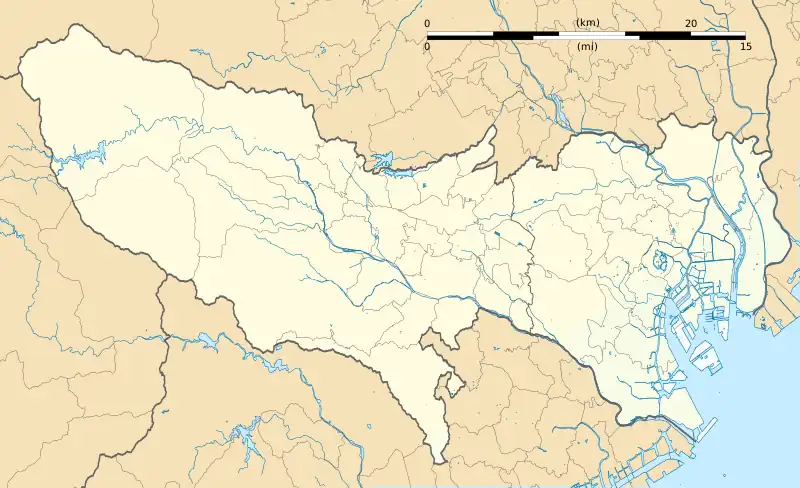JC74 Oku-Tama Station 奥多摩駅 | |||||||||||
|---|---|---|---|---|---|---|---|---|---|---|---|
 Oku-Tama Station in September 2021 | |||||||||||
| General information | |||||||||||
| Location | 210 Hikawa, Okutama-machi, Nishitama-gun, Tokyo 198-0212 | ||||||||||
| Coordinates | 35°48′32.8572″N 139°5′47.81″E / 35.809127000°N 139.0966139°E | ||||||||||
| Operated by | |||||||||||
| Line(s) | JC Ōme Line | ||||||||||
| Distance | 37.2 km from Tachikawa | ||||||||||
| Platforms | 1 island platform | ||||||||||
| Other information | |||||||||||
| Status | Staffed | ||||||||||
| Station code | JC74 | ||||||||||
| Website | Official website | ||||||||||
| History | |||||||||||
| Opened | 1 July 1944 | ||||||||||
| Previous names | Hikawa Station (until 1971) | ||||||||||
| Passengers | |||||||||||
| FY2019 | 966 | ||||||||||
| Services | |||||||||||
| |||||||||||
| Location | |||||||||||
 Oku-Tama Station Location within Tokyo  Oku-Tama Station Oku-Tama Station (Japan) | |||||||||||
Oku-Tama Station (奥多摩駅, Oku-Tama-eki) is a passenger railway station in the town of Okutama, Tokyo, Japan, operated by the East Japan Railway Company (JR East). It is the western-most station in the Tokyo Metropolis.
Lines
Oku-Tama Station is the western terminus of the Ōme Line, located 37.2 kilometers from the starting point of the line at Tachikawa Station.
Station layout
The station has one island platform serving two dead-headed tracks. The station is attended.
Platforms
| 1-2 | JC Ōme Line | for Ōme, Tachikawa, Shinjuku, and Tokyo |
 The curved island platform.
The curved island platform. Dead end of track 1
Dead end of track 1 Dead end of track 2
Dead end of track 2
Holiday Rapid Okutama trains and irregular trains are departed/arrived from/at Track 2. The departure melodies are Donguri Korokoro, and differ between Track 1 and 2.
History
The station opened on 1 July 1944 as Hikawa Station (氷川駅). It was renamed Oku-Tama Station on 1 February 1971. It became part of the East Japan Railway Company (JR East) with the breakup of the Japanese National Railways (JNR) on 1 April 1987.
Route buses
There are bus stops in Hikawa barn which Nishi Tokyo Bus has in the front of the station.
| Bus stop | No | Via | Destination | Company | Note |
|---|---|---|---|---|---|
| 1 | [奥20] | Kawanori-bashi | Nippara Shōnyūdō | Nishi Tokyo Bus | Runs only on weekdays for Nippara Shōnyūdō |
| [奥21] | Higashi-Nippara | ||||
| 2 | [奥09] | Lake Okutama・Mineya-bashi・Miyama-bashi | Kamozawa-nishi | ||
| [奥10] | Tabayama | ||||
| [奥11] | Tozura | ||||
| [奥12] | Kosuge-no-Yu | ||||
| [奥12] | Lake Okutama・Mineya-bashi・Miyama-bashi・Mount Daibosatsu Higashiguchi | Kosuge-no-Yu | |||
| [奥14] | Lake Okutama・Mineya-bashi | Mineya | |||
| [奥15] | Umekubo・Sōdake | Lake Okutama | |||
| 3番 | [奥30] | Kamba・Shiromaru Station・Hatonosu Station・Kori Station・Kawai Station (Tokyo) | Kami-Hinata | ||
| [奥31] | Seitō-bashi | ||||
| [奥32] (circular-route) | Nagahata・Kamba・Moegi-no-Yu | Okutama Station |
Passenger statistics
In fiscal 2019, the station was used by an average of 966 passengers daily (boarding passengers only).[1]
The passenger figures for previous years are as shown below.
| Fiscal year | Daily average |
|---|---|
| 2005 | 955[2] |
| 2010 | 902[3] |
| 2015 | 966[4] |
Surrounding area
- Okutama Town Hall
- Tama River
 National Route 411
National Route 411
See also
References
- ↑ 各駅の乗車人員 (2020年度) [Station passenger figures (Fiscal 2020)] (in Japanese). Japan: East Japan Railway Company. Retrieved 29 January 2021.
- ↑ 東京都統計年鑑 平成17年 9 運輸及び通信 [Tokyo Metropolitan Government statistics (fiscal 2005)] (in Japanese). Japan: Tokyo Metropolitan Government. Retrieved 26 March 2021.
- ↑ 東京都統計年鑑 平成22年 [Tokyo Metropolitan Government statistics (fiscal 2010)] (in Japanese). Japan: Tokyo Metropolitan Government. Retrieved 26 March 2021.
- ↑ 東京都統計年鑑 平成27年 9 運輸及び通信 [Tokyo Metropolitan Government statistics (fiscal 2010)] (in Japanese). Japan: Tokyo Metropolitan Government. Retrieved 26 March 2021.
External links
![]() Media related to Okutama Station at Wikimedia Commons
Media related to Okutama Station at Wikimedia Commons
- Official website (in Japanese)